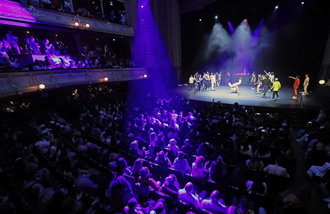Yongsan Park to be expanded to cover 2.4 square kilometers
Yongsan Park to be expanded to cover 2.4 square kilometers
Posted May. 12, 2011 02:03,
Seoul`s Yongsan Park to be built on the site of the U.S. military base that will be returned to Korea in 2016 will cover 2.4 square kilometers.
The Land, Transport and Maritime Affairs Ministry said Wednesday that it will designate and announce the Yongsan Park development area in a move to develop the park into a national park and manage the surrounding areas systematically.
The development area will encompass a Yongsan Park development zone, general facilities zones, and park outskirts zone. Of these, the development zone will cover 2.43 square kilometers excluding 220,000 square meters to be used for the U.S. Embassy, heliport and Dragon Hill Lodge of the 2.65 square kilometers at the base comprising the Main Post and South Post districts.
By considering the historical background of Yongsan as a base of foreign militaries for more than 120 years, the ministry plans to develop the area into a national park that incorporates national and historical spirit and cultural significance.
The 180,000-square meter area, which includes Camp Kim, the U.N. Command and the transportation department of the Yongsan military base, will be created as general facilities zones to play commercial, residential and cultural functions.
In addition, nearly 9 square kilometers encompassing Yongsan International Business District, Seobinggo apartment complex, Hannam redevelopment promotion district and Huam-dong near the two zones have been designated the park outskirts zone through consultations with the Seoul Metropolitan Government to prevent reckless development.
This zone surrounding the park will be developed in a systematic fashion through a separate urban development plan to be set by the city government.
The ministry has a basic plan on investment of 1.2 trillion won (1.1 billion U.S. dollars) to develop Yongsan Park and its vicinity, and is coordinating with related agencies. For starters, the development zone will be developed into six sectional parks for which transportation and transit systems will be established to assure convenient travel.
The sectional parks will comprise parks for eco-belt, cultural legacy, gate, global culture, U-eco theme and production. To limit damage on existing ecosystems and the environment, the ministry plans to minimize the construction of new buildings and instead use existing buildings as much as possible.
The building-toland ratio will be limited to less than 10 percent, about half the ceiling of that for urban parks.
The three general facilities zones, scattered at three locations surrounding the park development zone, will be developed to raise funds required for the relocation of the Yongsan military base to Pyeongtaek, Gyeonggi Province. The relocation will cost an estimated 3.4 trillion won (3.16 billion dollars).
Camp Kim is designated a greenery zone, the U.N. Command a grade 3 residential district, and the transportation department a grade 2 residential district. The ministry plans to change these districts into general commercial districts whose legal floor area ratio is 800 percent to allow the construction of skyscrapers there.
Under law, buildings up to 50 stories and an average of 40 stories can be built in areas with a floor area ratio of 800 percent or less, which could significantly increase the income of developers from building space sale.
The Seoul Metropolitan Government is opposed to this plan, however, saying housing of up to 30 percent can be allowed in general commercial districts. As such, the ministry and the city will likely have difficulty in trying to hammer out differences.
The city government reportedly prefers changing the districts into sub-residential areas, whose the housing ratio can reach up to 70 percent.
The ministry plans to finalize a basic general development plan, which entails direction for development and management of the park and surrounding areas through consultations with the city and the Defense Ministry. Once the plan is finalized, a developer will be selected to devise an implementation plan on general facilities to finalize the basic framework for the project`s inauguration.
leej@donga.com






